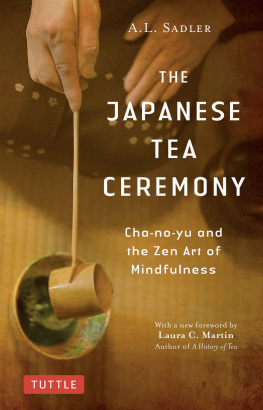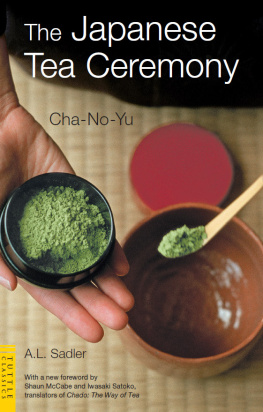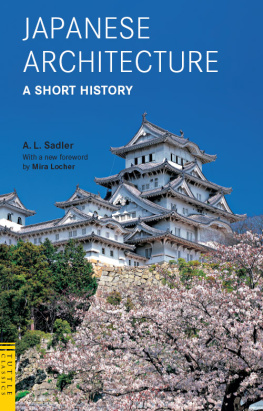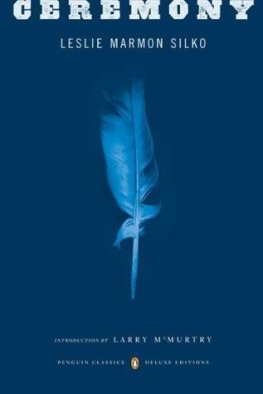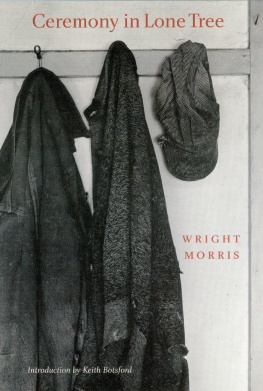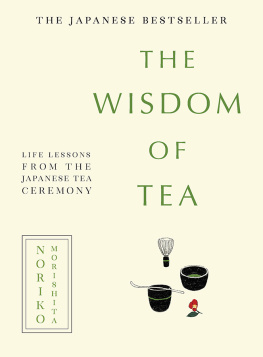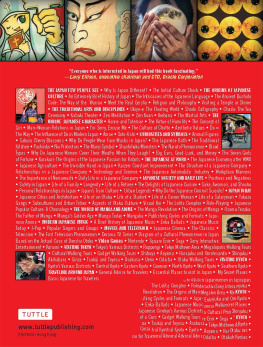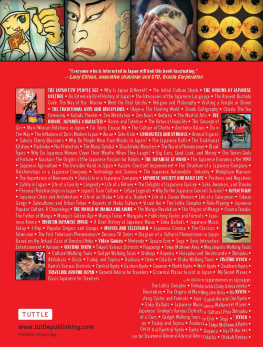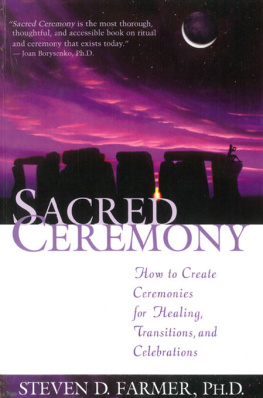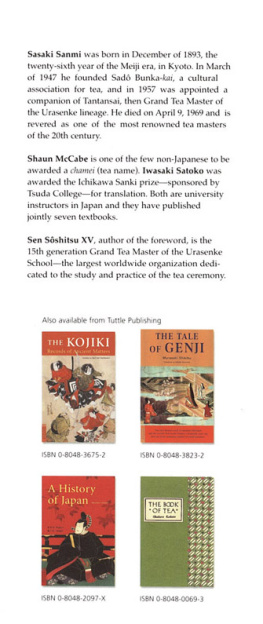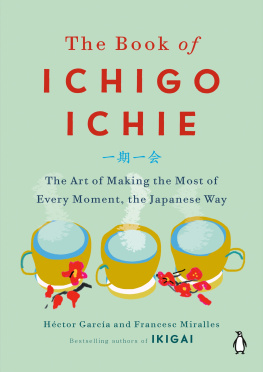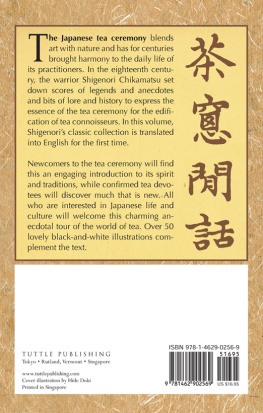THE
JAPANESE TEA CEREMONY
The late A.L. Sadler was Professor of Oriental Studies at the University of Sydney for twenty-six years and thereafter Professor Emeritus. He also served as Professor of Japanese at the Royal Military College of Australia. Professor Sadler was one of the most renowned experts on Japanese history and culture, as well as a superb translator of Japanese into English. His other works include The Warriors Code, Shogun: The Life of Tokugawa Ieyasu and Japanese Architecture: A Short History.
THE
JAPANESE TEA CEREMONY
Cha-no-yu and the Zen Art of Mindfulness
A.L. SADLER

ABOUT TUTTLE
Books to Span the East and West
Our core mission at Tuttle Publishing is to create books which bring people together one page at a time. Tuttle was founded in 1832 in the small New England town of Rutland, Vermont (USA). Our fundamental values remain as strong today as they were thento publish best-in-class books informing the English-speaking world about the countries and peoples of Asia. The world has become a smaller place today and Asias economic, cultural and political influence has expanded, yet the need for meaningful dialogue and information about this diverse region has never been greater. Since 1948, Tuttle has been a leader in publishing books on the cultures, arts, cuisines, languages and literatures of Asia. Our authors and photographers have won numerous awards and Tuttle has published thousands of books on subjects ranging from martial arts to paper crafts. We welcome you to explore the wealth of information available on Asia at www.tuttlepublishing.com.
Published by Tuttle Publishing, an imprint of Periplus Editions (HK) Ltd
www.tuttlepublishing.com
Copyright 2008, 2019 Charles E. Tuttle Co, Inc.
Cover photo by Xavier Comas
All rights reserved. No part of this publication may be reproduced or utilized in any form or by any means, electronic or mechanical, including photocopying, recording, or by any information storage and retrieval system, without prior written permission from the publisher.
Library of Congress Catalog No. 62-19787
ISBN 978-1-4629-2063-1
Distributed by
North America, Latin America & Europe
Tuttle Publishing
364 Innovation Drive
North Clarendon,
VT 05759-9436 U.S.A.
Tel: 1 (802) 773-8930
Fax: 1 (802) 773-6993
www.tuttlepublishing.com
Japan
Tuttle Publishing
Yaekari Building, 3rd Floor
5-4-12 Osaki, Shinagawa-ku
Tokyo 141 0032
Tel: (81) 3 5437-0171
Fax: (81) 3 5437-0755
www.tuttle.co.jp
Asia Pacific
Berkeley Books Pte Ltd
3 Kallang Sector #04-01
Singapore 349278
Tel: (65) 6741 2178
Fax: (65) 6741 2179
www.periplus.com
22 21 20 19 10 9 8 7 6 5 4 3 2 1 1810RR
Printed in China
TUTTLE PUBLISHING is a registered trademark of Tuttle Publishing, a division of Periplus Editions (HK) Ltd.
FOREWORD
by Laura C. Martin
The Japanese tea ceremony, with its Zen symbolism, ordered elegance and strict attention to the present, holds the same lure today as it did hundreds of years ago. Along with a current interest in Zen Buddhism in the West, interest in the tea ceremony has also increased. Thus, it is no surprise that A.L. Sadlers The Japanese Tea Ceremony: Cha-no-yu and the Zen Art of Mindfulness remains a classic to be studied and enjoyed.
Though he wrote on many topics of Japanese culture, The Japanese Tea Ceremony is Sadlers best known and most beloved book. It was the tea ceremony that provided Sadler with a rich treasure for endless contemplation, exploration and practice. Sadlers book became my bible in my own studies of tea and the tea ceremony. It was through his insight that I began to understand how tea, different from any other beverage, has helped shape and transform countries and cultures and that the tea ceremony, while outwardly a simple communal enjoyment of a beverage, possesses a far deeper meaning.
Arthur Lindsay Sadler was born in London in 1882. At an early age he showed an aptitude for learning and a genius for languages. Graduating with a degree in Oriental languages, he left England in 1909 to teach English and Latin in Japan. A large and solid man with blonde hair and blue eyes, Sadler always stood out among the Japanese. Although he loved everything Japanese, he never managed to fit in while living there. In 1922 he moved to Australia and was named professor of Oriental Studies at the University of Sydney.
Sadler uses the word Teaism (coined by Okakura Kakuzo in his work The Book of Tea) to refer to the culture surrounding tea and the tea ceremony in Japan. The main idea of Teaism, he says, is a quiet simplicity (wabi) and a mellow experienced taste (sabi.) He suggests that for those taking Cha-no-yu, it was a way of abstracting themselves for a while from the bother and stress of everyday life. It was becoming a recluse for an hour or two. Teaism means contentment, Sadler writes, and it is this quest for contentment that is central to understanding the true nature of the tea ceremony. The tea ceremony offers a kind of magic, an intimacy, a shared moment of perfection.
In the first part of the book, Sadler proves himself to be a masterful scholar as he explains in careful detail the history of tea and the intricacies of the tea ceremony. He begins with the origin of tea in China, then describes the tearoom, utensils, the garden (called Roji) the stone lanterns and water basin, pottery and flower arrangements. The steps for the ceremony itself are detailed including the best times to perform Cha-no-yu (literally hot water for tea), the order of the meal, the duties of the host and the correct response from guests.
The three essential elements of a ceremony include the arrangement of each component (tea, utensils, guests and host); the cleanliness of the items (including the hearts of the guests and host); and the importance of a calm mind and outward demeanor of the participants. The ceremony begins when the host greets guests outside and leads them through a low door (called a wriggling-in entrance) into the teahouse. A simple, seasonal meal is served. After the guests have eaten, the host invites them to retire to the garden while the tea is prepared. When ready, the host calls the guests back in. He then purifies each component with great attention and reverence, scooping tea into the tea bowl, ladles hot water into the bowl and whisks it. The tea is then offered to the guests, in order of their importance or prominence. After the guests have finished, the bowl is rinsed and dried and all the items are presented to the guests to examine and admire.
Sadler writes that there are only three Sounds of Tea the first is the clink of the lid on the kettle, the second is the tap of the tea bowl on the mat and the third is the clink of the teaspoon on the tea bowl. Except for these sounds, the ceremony is performed in complete silence. Thus, distractions are limited and simplicity is embraced where each movement holds a special significance. In this way, the ceremony becomes an object of conscious meditation in a search for mindfulness.
In its essence, the tea ceremony is like any other art where years of study are necessary to do it with grace and a depth of understanding and skill. The masters say that it takes ten years of dedicated study to do it right. Sadler describes 37 steps to perform the ceremony, all of which are included for the purpose of showing close observation and attention, respect and admiration. But as is the case with any art, this only scratches the surface.
Next page
